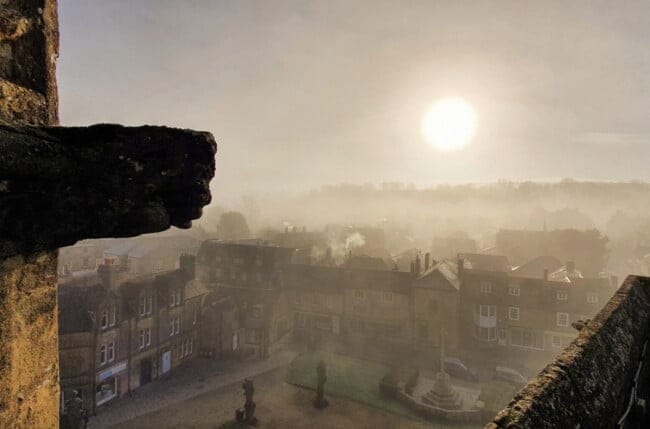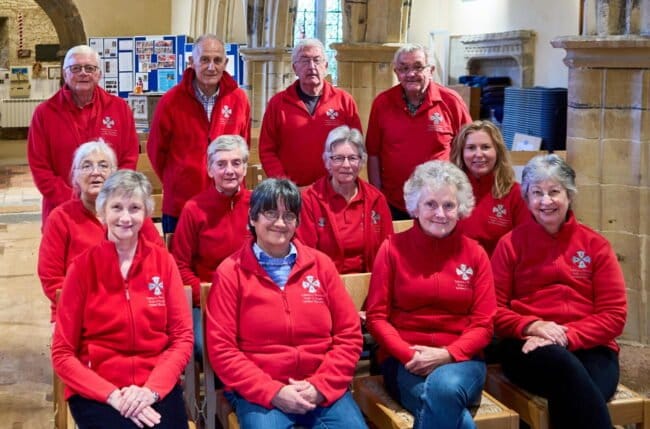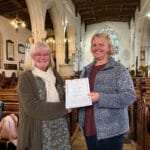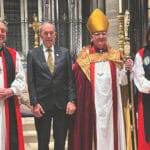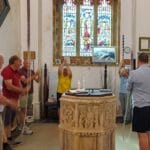Westbury is famous for its White Horse, a 180-foot (55 metre) high figure cut into the side of the Bratton Downs in 1772. Visible for 15 miles in good weather, the horse has become the symbol of the town as well as its best-known feature. However, what many don’t know is the Church of All Saints, located just off the Market Place in the oldest part of the town, contains the third heaviest ring of eight in the world, widely considered to the finest ring of its kind in the country. Just how did a small Wiltshire town become the home of such a prestigious and large set of bells? Read on to find out!
Old bells
Westbury’s central tower is unusual, for though most church towers are not precisely square, Westbury’s is very obviously rectangular; far larger E-W than N-S. The tower was built in several stages, the lowest two stories, originally both open to the church, were constructed between 1340 and 1380 as part of a major rebuilding campaign of the entire building. The belfry stage of the tower would not follow until 1437, which gives us a fair indication of the time at which bells would have first been placed within it. The first record of bells at Westbury is in the Church Goods Survey in 1553, where the tower already has six bells.
In 1616, the bells were rehung in a new timber frame specifically designed for six bells, which implies that the bells recorded in 1553 had already been augmented at least once. Coinciding with this work, the fifth was recast by Roger Purdue I at this time, followed by the third in 1620, again by Purdue. The treble was recast by Warminster founder John Lott in 1671, followed by the tenor by Abraham Rudhall I of Gloucester in 1714, the 2nd by William Cockey of Frome in 1738 and lastly the 4th by Thomas Mears II of Whitechapel in 1838.
19th and 20th century alterations
With a tenor reputed as being 35 or 36 cwt, these were one of the heaviest rings of six in the country; the treble alone was over 11 cwt. Until 1755, these bells would have been rung from the ground floor, it was not until this year that the churchwardens petitioned for the installation of a ringing loft and two new bells. A shortage of funds meant only the floor was inserted to form a ringing room in the second storey of the tower, the two new bells did not materialise. Ringing such heavy bells with such long ropes, on primitive fittings, would have been extremely hard work: it is reported in The Bell News in March 1884 that it took eleven men to ring them!
Even after the installation of the ringing chamber, and thus the shortening of the ropes by around 40 feet, the bells were still incredibly difficult. In 1884, an attempt was made by Mears & Stainbank to improve the ‘go’ of the bells by rehanging them all on new gudgeons, strengthening the frame, and replacing all the wheels. Even after this work, the tenor still took two men to ring. In 1894, another attempt was made, this time by Thomas Blackbourn of Salisbury, who rehung the back three on new fittings. Mears and Stainbank did the same to the front three in 1910.
At this time, the bells were still hung in their 1616 frame, which was made by local carpenters William Francis and William Andrews. Though not dangerous, it had been patched up several times and was probably not strong enough for such a large ring of bells. This frame was actually two separate constructions, with the front three swinging on the south side of the tower, and the heaviest three on the north, separated by a walkway. All six bells swung through the same N-S axis, which would have made for considerable tower movement.
Restoration
In 1919, following the First World War, the parish embarked on an ambitious restoration programme of the bells. The original scheme, as agreed with John Taylor & Co of Loughborough, was to recast the treble and third and to rehang all six with new fittings in a new metal frame. It was later agreed to augment the bells to eight with two newly cast trebles, and the old bells and fittings left Westbury on 7th October 1920. Upon their arrival at the foundry, the bells were weighed before tuning and restoration, where it was found that the tenor was 30cwt-2qtr-14lb, which made it, narrowly, the second heaviest bell in the county, that at Holy Trinity Bradford on Avon was a mere quarter of a hundredweight bigger before its retuning in 1998.
However, after inspecting the bells in the foundry, a problem occurred. Taylor’s had found that none of the six bells could be adequately retuned, and therefore proposed recasting all six bells, for an additional cost. Two options were given, a newly cast ring of eight with a 30 cwt tenor in the key of C#, or a heavier ring of eight with a 34 cwt tenor in the key of C. To see if this was really necessary, a deputation of senior Guild members travelled to Loughborough on 6th April 1921 to inspect the bells. These included the General Secretary of the Guild, none other than Mr F. Llewellyn Edwards, after whom our Bell Restoration Fund is now named. The deputation was to decide if such “drastic” action was really necessary, and if it was, which of the two proposed options would be better.
The findings of the deputation were that Taylor’s were correct, no satisfactory result could be obtained without recasting of all six bells. On the two proposed options, they felt that whilst the 30 cwt ring of eight would nonetheless be a very fine octave in their own right, the larger option would mean that Westbury would possess a ring with “grandeur and deepness of tone to render them famous throughout the South-West of England”, as well as the fact that a larger tenor would provide the opportunity to augment the bells to ten at some future time. Therefore accepted the scheme to recast all six bells, add two more, rehang them in a new metal frame, and add additional metal to make them into a slightly heavier ring.

The cost of the scheme consequently increased from the original, and the parish was still £300 short when they accepted it. The final bill for the scheme was a whopping £2,068, equivalent when allowing for inflation, to £84,300 in March 2024. (Data from the Bank of England’s Inflation Calculator).
This bill included the original £866 for the recasting of the treble and third, as planned, plus an additional £251 for the new trebles, £650 for the recasting of the others, new clock hammers, new fittings, removal of the floor above the bells, new rope bosses, and carriage.
There was also an additional charge for an inscription on the 7th bell, whose predecessor was given by Sir James Ley, 1st Earl of Malborough. The recast bell has a special inscription, featuring the arms of the Earl.
The bells arrived back in Westbury in October 1921 and were first rung at a spectacular dedication service on the 29th of that month. Over 200 ringers were present at the service, from as far afield as Newport in Wales, Sheffield, and London, as well as from towers across the Diocese. Despite assertions from H. B. Walters, a noted bell historian at the time, that the recasting was “quite unnecessary”, the opinion of those present was unanimous, that the restored ring was the finest ring of eight in existence, an opinion that still holds today: during the pandemic lockdowns, the bells easily won an online competition in the Bellringers’ Facebook Group (which has several thousand members) for the best heavy eight.
With a tenor weighing 35 hundredweight and 14 pounds, the bells are the second heaviest ring of eight in the country, after only Sherborne Abbey, which curiously means the Guild houses both of the country’s heaviest octaves. Following the casting of Adelaide Cathedral’s new eight in 1946, also by Taylor’s, Westbury was relegated to third place overall in weight lists, as the former’s tenor is some quarter of a ton larger. The final bill of just over £2,000 was not settled until August 1922 by the parish, and the bells have recently celebrated their 100th birthday.
The bells are a magnificent ring, arguably the finest sounding peal the Guild possesses. Despite a little tower movement, the bells go for their weight exceptionally well, and being both, loud, boomy, and resonant, the bells are a pleasure to the ear too. The bells are well looked after, and remarkably, possess a full set of original wrought-iron clappers. Wrought iron is no longer used in the manufacture of clappers, and many towers have since replaced their clappers with the now-standard spheroidal graphite, an alloy, which many consider to have inferior properties to wrought iron. The clappers date from 1921, and apart from rebushing at regular intervals, are, like the rest of the fittings, essentially as Taylor’s left them in 1921.
The bells are thus an exceptionally fine example of the founder’s work and a ring of bells in general. Whilst many church buildings themselves are Grade listed, the bells are Westbury are also listed as historically important. In an era where new rings were churned out at massive frequencies in the 20th century, only 78 bells cast since 1900 have been listed for preservation – Westbury accounts for 8 of them – further demonstrating their extraordinary history and quality.
Other bells and clock

The tower also contains two further bells, both historically important. The ‘younger’ of the two bells dates from circa 1600 and is the tower’s own Sanctus bell, weighing approximately one and a half hundredweight but is now disused. The older bell is an extremely important casting of circa 1200 brought to the church in 1965 from St Mary’s at Old Dilton, and the age of the bell is evident with its unusually tall, thin, shape. This bell also weighs one and a half hundredweight and is one of the oldest bells in the Diocese.
If all this were not enough, the ringing chamber is home to a fascinating and uncommon, faceless clock, made by a local blacksmith in 1601. The clock has been restored several times, most recently when it was converted to electric and automatic winding in 2002. The clock chimes are in the ‘ting-tang’ fashion, striking the quarters on the 4th and 6th bells, with the hour on the tenor. The clock occupies a large timber and glass case in the southern corner of the ringing chamber.
A visit to Westbury is a thrilling experience for almost any ringer. The bells are of a quality seldom found outside the major cathedrals, they are well-maintained, easy on the ear, and incredibly rewarding to ring. The history of the tower is evident from the many peal boards, framed photographs, and books, and thanks to a large window on the north side of the tower, there are excellent views to be had over the town.








